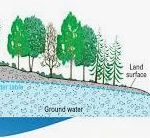The physical environment of our earth can be divided into four realms;
01. The solid part is known as the Lithosphere.
02. The liquid part is known as the Hydrosphere.
03. The part where living organisms are found is known as the Biosphere.
04. The air and gaseous part of the earth is known as the Atmosphere.
Lets have a closer look at these realsm:
Lithosphere
The Lithosphere encompasses the Earth’s solid outer layer, which includes the crust and upper mantle. The crust is further divided into Continental and Oceanic Crust. Beneath the crust, there is upper part of the mantle, which is quite solid and hard.
Lithospher=Upper Mantle+Earth’s Crust
The lithosphere provides the foundation for all other spheres, and most of the earth’s landforms are found on the lithosphere. Beneath the lithosphere there is a molten part of the mantle which is known as asthenosphere, which covers the Earth’s core.
Importance of Lithosphere
The lithosphere is an important part of the Earth’s system, which provides the basis/foundation for life, resources, and climate. Landforms develop on the lithosphere, which provides valuable resources to the human being. It also acts as an interaction between other realms of Earth.
-
- The lithosphere provides the landforms (mountains, valleys, plains, etc.) that serve as habitats for various species.
- It allows for the development of soils, which are essential for agriculture and food production.
- The lithosphere provides the landforms (mountains, valleys, plains, etc.) that serve as habitats for various species.
- It provides a stable platform for human settlements and infrastructure.
- The lithosphere is a rich source of minerals, fossil fuels, and metals, which are crucial for industrial activities and energy production.
- Tectonic plate movement can concentrate mineral deposits in specific areas, leading to the formation of resource-rich regions.
- The lithosphere interacts with the hydrosphere (water), atmosphere (air), and biosphere (living organisms).
- Weathering and erosion, driven by the hydrosphere and atmosphere, break down rocks and minerals in the lithosphere, making them accessible to the biosphere.
- The lithosphere also influences weather patterns and water flow due to its landforms.
- The lithosphere’s landforms, such as mountains and valleys, can affect regional weather patterns and climate.
- Volcanic eruptions and other geological processes originating in the lithosphere can impact the climate on a global scale.
- The movement of tectonic plates is a major driver of earthquakes and volcanic activity, which can have significant impacts on the planet.
- The lithosphere provides a stable surface for the other spheres to interact with.
- This interaction is crucial for the health and functioning of the entire Earth system.
Hydrosphere
All waters present on the Earth surface, and within the lithosphere, including oceans, seas, lakes, rivers, groundwater, and ice are included in this realm. Water is essential for all known forms of life and plays a crucial role in regulating climate and weather patterns. The planet’s hydrosphere can be liquid, vapor, or ice.
On Earth, liquid water exists on the surface in the form of oceans, lakes, and rivers. It also exists below ground—as groundwater, in wells and aquifers. Water vapor is most visible as clouds and fog.
The frozen part of Earth’s hydrosphere is made of ice: glaciers, ice caps and icebergs. The frozen part of the hydrosphere has its own name, the cryosphere.
Water moves through the hydrosphere in a cycle. Water collects in clouds, then falls to Earth in the form of rain or snow. This water collects in rivers, lakes, and oceans. Then it evaporates into the atmosphere to start the cycle all over again. This is called the water cycle.
Atmosphere
The atmosphere surrounds the solid part of the Earth and is a mixture of gases. The existence of life is possible because of the existence of the atmosphere, as it provides us with air to breathe, shielding us from harmful ultraviolet (UV) radiation released from the Sun. Atmosphere also traps the heat to warm the planet, and prevent it from the extreme temperature differences between day and night. Without the atmosphere, an average, temperature would be well below freezing on Earth’s surface. This temperature is regulated by insolation. Insolation refers to the amount of solar radiation reaching a specific area on Earth’s surface. It’s essentially the amount of sunlight that strikes a given location, and it’s a key factor in determining weather and climate patterns. Factors like latitude, time of day, and the angle of the sun’s rays all influence the amount of insolation a place receives. Instead, the heat absorbed and trapped by our atmosphere keeps our planet’s average surface temperature at a balmy 15°C (59°F). Some of the atmosphere’s gases, like carbon dioxide, are particularly good at absorbing and trapping radiation. Changes in the amounts of these gases directly affect our climate.
Biosphere
The zone of the Earth, where life is found is known as the biosphere. It encompasses all living things, and their interaction with other spheres of the earth, like hydrosphere, atmosphere, and lithosphere. In other words, the global sum of all ecosystems, ranging from deep ocean trenches to high mountain tops, and includes all plants, animals, and microorganisms. It’s the interconnected web of living organisms and their interactions with the non-living environment. Biosphere includes two main components, the biotic component (living organism), and the abiotic components (non-living like nutrients, water, food, air, sunlight, etc).
It reaches from deep-sea vents to the upper atmosphere, and from the deepest soil layers to high mountain peaks. The biosphere is a complex system where living organisms interact with each other and their environment. It provides the necessary conditions for life to exist and thrive.
Other Posts:


Leave a Reply